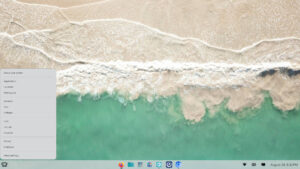If GNOME hadn’t irked many users when it redesigned its approach to the desktop with GNOME 3, there would be fewer popular desktop environments for Linux.
I recently took my first look at GNOME 3. I’d played around with GNOME 2 a couple of times back in 2002 and 2003, not caring for it very much. This was in small part due to the fact that on Mandrake 9.X, GNOME was unstable and prone to crashing, but mainly because I found it wasn’t configurable enough for my taste. I stuck with KDE, which even back in the dark ages of the early 21st century was uber configurable.
 When the brouhaha exploded after the release of GNOME 3, I wasn’t much interested in having a look for myself. However, a few weeks back I finally got some hands-on experience when I wrote a review of Antergos, which I installed with GNOME, not so much because I wanted to give the DE a look but because it’s the distro’s default.
When the brouhaha exploded after the release of GNOME 3, I wasn’t much interested in having a look for myself. However, a few weeks back I finally got some hands-on experience when I wrote a review of Antergos, which I installed with GNOME, not so much because I wanted to give the DE a look but because it’s the distro’s default.
In a nutshell, like many others I don’t care much for its new-to-me reinvention of the desktop, although there are a lot of aspects I did come to find useful after I learned my way around. I didn’t find it particularly difficult to learn, which had initially been a complaint from some, although I did have to ping a friend with a question about its implementation of virtual workstations.
In the end, I decided that the new direction the GNOME developers are taking the desktop probably suits many users fine, evidenced by the many desktops that use it as a default. This is good, since GNU/Linux has always been about choice. It just isn’t for me.
This doesn’t mean I don’t understand the uproar that erupted back in 2011 when the GNOME team first unveiled the future direction of what was then the most used Linux desktop. If I had been a loyal GNOME user who had supported the desktop for years, I would’ve been pissed by the sudden change, just as KDE users had been a few years earlier when it had introduced a radical new approach. KDE quickly did an about face and gave in to user demands. GNOME, much to the chagrin of loyal users, did not and has continued to boldly take the desktop where no desktop has gone before.
But while the change wasn’t good for a user base that was perfectly content with the desktop the way it was, an unexpected consequence stepped in that’s made the “new” GNOME one of the best things that’s happened to desktop Linux since the marriage of GNU with the Linux kernel. Funny thing: That unexpected consequence was a direct result of the disgruntled users who refused to have GNOME’s change of direction forced on them.
Due to GNOME’s change of direction, Linux users now have a much wider variety of desktop environments from which to choose than ever before. A quick glance at the list of now popular desktop environments that grew out of dissatisfaction with GNOME’s direction is impressive. There’s Unity, Ubuntu’s default, which is basically a redesigned UI plastered onto GNOME 3 (and not very popular with GNOME 2 fans, I might add). Linux Mint’s Cinnamon desktop began as a GNOME 3 fork and MATE also started as a fork — of GNOME 2.
Even SolusOS’ Budgie and Elementary’s Pantheon, both built “from the ground up” and for different reasons, freely borrow from GNOME components.
If the GNOME developers hadn’t changed their approach, it’s doubtful that Unity, Cinnamon or MATE would have been developed, since all three of these came out of a direct response to GNOME’s change. And if Unity, Cinnamon and MATE hadn’t proved to be so popular, illustrating the viability of new desktop environments, it’s doubtful that Budgie or Pantheon would’ve ever come along.
So GNOME 3 has not only taken the bold step of exploring new ways to perceive the desktop, it has added new desktops to the Linux and FOSS gene pool.
From where I sit, that’s a good thing.
Christine Hall has been a journalist since 1971. In 2001, she began writing a weekly consumer computer column and started covering Linux and FOSS in 2002 after making the switch to GNU/Linux. Follow her on Twitter: @BrideOfLinux




“This was in small part due to the fact that on Mandrake 9.X, GNOME was unstable and prone to crashing, but mainly because I found it wasn’t configurable enough for my taste.”
Oh! It sounds exactly like an operating system I was using in ’02 and ’03, too! I believe it was called…Windows?
Linux is somehow seeming less and less alien…
@Robert Glen Fogarty Mandrake was extremely stable running KDE, which was it’s default desktop. I used it for about seven years. And GNOME has always been designed to be relatively unconfigurable. Part of the GNOME philosophy has always been that making a desktop too configurable only confuses the user, or some such nonsense. As I said, one of the reasons I don’t like GNOME. 🙂
> the GNOME philosophy has always been that making a desktop
> too configurable only confuses the user, or some such
> nonsense.
Yes, *that* is nonsense. Unsurprisingly, one that still gets peddled around by journos looking for clickbait.
The GNOME philosophy has been that *unnecessary* configuration options place an undue burden on the developers, who have to deal with the cost of implementing, documenting, and testing all the possible combinations; and on the users, who have to deal with the cognitive overload of a ton of subtly different options, especially the “unbreak my system” ones. Instead of giving you a check box, GNOME favours *fixing* the underlying issue (going down to the kernel, if necessary); providing sane defaults; and giving users a designed, cohesive whole.
But, sure: it’s easier to say that GNOME developers removes options because they are confusing to the poor users.
> “The GNOME philosophy has been that *unnecessary* configuration options place an undue burden on the developers…and on the users…”
…and the GNOME developers are the sole arbiters of what is unnecessary. Just like with systemd, they are mostly full of crap.
In the world according to GNOME, it must be INCREDIBLY AMAZING to see how many other desktops seem to manage to limp along while still providing configuration options to end users instead of getting the message that users are sheep to be led around by the nose.
I don’t agree, KDE always crashes for me from the days of Mandrake 9x to today, when we have Plasma 5.7 ,Gnome is my preferred DE, always stable , GNOME 3.20 is better than GNOME 2 in everyway.
Checkout ArchDistro Stats, now since 8 months GNOME 3 is ahead of KDE, which is third place, before that KDE used to be first.
For a normal nontech user GNOME is better than KDE, GNOME 3 though initially was unpopular is now far ahead of KDE in popularity, many distros are now using GNOME 3 as default env or using in under the hood.
GNOME3 also gave a big boost to XFCE as refugees fled from GNOME. The bigger questions are whether the GNOMEs handled the situation in a professional way and could the changes have been made in a less disruptive way.
The GNOME fiasco, like so many before, rendered about half of the Linux world’s desktops unsuable. This, as noted in the article, was not a one off. KDE has done it too, we had the pulse audio fiasco that made most Linux desktops mute for a couple of years and now the systemd insanity roiling the world. The key thread is distros (don’t blame developers) rolling out half baked rewrites years before they are ready for production. It is one thing to early release software that is an optional addition to the available software or fills a gap where there are no better Free Software options. Replacing working software loved by many with broken is different. Done so many times now it drives home the notion that Linux isn’t intended for serious use, that it is a nerd toy.
Worse, the GNOMEs realized that GNOME2 would be their most serious competition so they intentionally designed GNOME3 so it would be impractical to install both versions in parallel. They were shocked when the MATE project invested the considerable manhours required to work around that problem. It was perfectly fine for GNOME to change directions, their labor is theirs after all; what wasn’t perfectly fine was trying to bury GNOME2. And again, the primary blame goes to the distros for the uptake of version 3 before it was usable.
As for the professionalism of the GNOMEs, no. At every stage they responded to criticism with STFU or worse. I wouldn’t want to see any of their names on a team I cared about the product of.
“As for the professionalism of the GNOMEs, no. At every stage they responded to criticism with STFU or worse.”
Another project with the same modus operandi: systemd. Funny how a lot of the same names are on both projects.
I never did like Gnome anything from the get go. KDE was it for me for a lot of years… Until KDE4 arrived. Then I started looking for alternates and landed in LXDE and XFCE land. Much more to my tastes…. And that is what is it… Taste, personal preference. I like it ‘simple’ and to the point intuitive, fast. At any right I agree, when a desktop flubs up or makes changes you don’t like, alternates sure get more attention which I think is point of article 🙂 .
I am sorry, but your argumentation is wrong:
– Unity is not a response to GNOME 3, both if them appeared at the same time and there was a big conflict between the teams, each of them claiming they were first;
– MATE and Cinnamon are not really needed, most of their users (and this includes me) would have preferred they never happened and GNOME continued the sane way.
@nicu Mark Shuttleworth had Unity developed because he didn’t like the direction that GNOME was going.
“Ubuntu founder Mark Shuttleworth cited philosophical differences with the GNOME team over the user experience to explain why Ubuntu would use Unity as the default user interface instead of GNOME Shell, beginning April 2011, with Ubuntu 11.04 (Natty Narwhal).”
And MATE and Cinnamon were both developed to address the needs of GNOME users who were unhappy with GNOME 3.
Gnome3 borrowed heavily from Unit — especially the launcher. I did a youtube video of Fedora 14 years ago. Gnome3 was a much different beast.
https://www.youtube.com/watch?v=sm15Tscd6R4
“But, sure: it’s easier to say that GNOME developers removes options because they are confusing to the poor users.”
You speak as though what you said are the real reasons were entirely different than this statement, when in reality, what you said is only slightly different. It’s easy to sum up what you said are the real reasons, like so: “GNOME developers remove options because they make the environment harder to maintain and they are too confusing to users.” It’s not really that different, than the statement you are refuting; it mostly just has a different attitude.
Either way of looking at this may have merit depending on what you find desirable in a desktop. Personally, GNOME never appealed that much to me, but then neither did KDE. I have tended to use Xfce, LXDE, Fluxbox, and IceWM, depending on the time, the hardware, etc. (I actually used Xfce when Xfce wasn’t cool.)
Spin it whichever way you want – the truth is that Gnome 3 fills a much-needed gap in the Linux desktop.
On my laptop I run for more than 10 years(!) WinXP without ever suffering a single crash or other OS problems. Power mangement, external displays, external keyboard and mouse, docking station, many in parallel open software (Office, math and biomedical simulation software, programming IDEs) run without hampering my workflow. Still today none of the Linux distros provides me a competitive desktop. With XFCE, LXDE and LXQt I get my basic work done on it. But the workflow is suboptimal because of the many times that the system freezes or my external hardware is not supported. It feels like being back on Win95 stability and WinNT4 connectivity again. Gnome3 indeed solved all this for me and therefore I could like it – if the Gnome-Shell would react immediately on my requests instead of letting me wait for 15(!) seconds for opening the applications menu or the activity view (etc.) and if the vertical scroll bars could be configured to once be wide enough for usability. I could not even in the IRC get proper information on how to get wide enough vertical scrollbars. Welcome, Year of the Linux Desktop!
> “Spin it whichever way you want – the truth is that Gnome 3 fills a much-needed gap in the Linux desktop.”
Spin it whichever way you want – the truth is that Gnome 3 is a pile of crap and a lot of users realize it.
I don’t know why all the fuss. We, the linux users, have a freedom of choice. If you don’t like GNOME, you will certainly find another DE that suits your needs.
Personally I’m a GNOME user. I have used it from the first versions of Ubuntu some 15-16 years ago. I switch from version 2 to version 3 and I will confess that I didn’t like the first iterations at all. They were filled with bugs, they were slow and had so many problems and even less configuration options. But I stayed with it because other DE’s just didn’t cut it for me. Over the years GNOME became stable, those initial bugs cleared and it got much faster and with a slick interface.
Today I’m really happy with it. I really don’t focus much on the configuration of the DE myself, rather the work I’m doing on it, so 10 minutes needed to change the theme, icons and some other small stuff with Tweak is the time I want to spend to configure it.
And for people who want to customize it to the full there are always extensions and the docs how to build them.
And lastly I like the modern look. I know a lot of people love the look of the 90’s on their computers but I like to stay with the century I’m in. I like the transitions, flat designs, icons etc.
So in the end it’s really a personal choice, no need to go all batshit crazy about a particular DE because you personally dislike it. 🙂
@Infinitum, not so much. For a former GNOME user, GNOME 2.30 is the best Linux desktop ever, nothing else is as good, neither GNOME 2.32, when the sumbing-down started, preparing for 3.x, neither MATE which after so many years is buggier, neither Cinnamon which is too GNOME 3, neither Unity which is also a tablet UI, neither Xfce which is too weak in features and development speed.
The issue with GNOME 3 is not changing the look, but changing the workflow and slowing you down. People ‘go all batshit crazy’ because their perfectly running desktop was ruined for no solid reason, just for the change’s sake.
@Emmanuele Bassi
I think when they started removing the ability to do things like printing on both sides of a page even if the printer and driver supported it to make the print dialog smaller – that argument was disproven completely, and Christine Hall’s assessment became the only supportable one.
I cite that example because it was also the one that got Linus to declare that he always tells people to just use KDE instead – so it’s famous, well documented and easy to look up, but it was nowhere close to being the most egregious.
Of course you should provide sane defaults – but you should NEVER EVER make it impossible to CHANGE the defaults. That is NEVER a good idea. No two people are identical, no two users have exactly identical needs or workflows – it must always be possible to make the computer work like YOU want it to, not for you to work like the computer wants.
I must admit that Gnome devs had right about direction. I like Gnome 3 (gnome-shell) design principles. But in details they provide questionable decisions sometimes.
For example we could choose from list of seven options which action assign to power button in gnome-shell 3.16. Now in 3.20 we are limited to only three of them. I don’t get it.
So, come out and say it! GNOME 3.X Has Been Good for Linux and FOSS because it sucks! It sucks pond scum thru one of those crummy, little bar straws.
Give us something, anything, to take us away from this cellphone-centric travesty.
And, as if it weren’t bad enough by itself, GNOME 3 necessitates the inexecrable systemd in order to support it. It screams to be left behind, like the fat jerk in ‘The Paper Chase”.
And to do that, to leave this massive scum-sucking monument to what-we-don’t-want behind, will be a very, very good thing for Linux. Maybe we can then catch up to what we were five or so years ago.
Because it’s so much better to have 8 unfinished, unpolished DEs than 2 mature ones and a handful of experimental options. Truth be told, the chaos ensuing from the Gnome 3 release (which still hasn’t produced a really usable alternative) drove me away from Linux on the desktop entirely. In 5 years, not one linux DE has been able to reproduce the usability (for me) of Gnome 2, especially regarding configurable panels, hotkeys, and multiple monitor support.